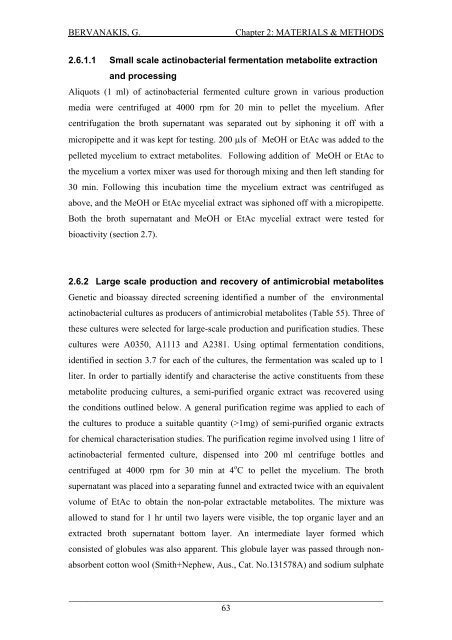Detection and Expression of Biosynthetic Genes in Actinobacteria ...
Detection and Expression of Biosynthetic Genes in Actinobacteria ...
Detection and Expression of Biosynthetic Genes in Actinobacteria ...
Create successful ePaper yourself
Turn your PDF publications into a flip-book with our unique Google optimized e-Paper software.
BERVANAKIS, G.Chapter 2: MATERIALS & METHODS2.6.1.1 Small scale act<strong>in</strong>obacterial fermentation metabolite extraction<strong>and</strong> process<strong>in</strong>gAliquots (1 ml) <strong>of</strong> act<strong>in</strong>obacterial fermented culture grown <strong>in</strong> various productionmedia were centrifuged at 4000 rpm for 20 m<strong>in</strong> to pellet the mycelium. Aftercentrifugation the broth supernatant was separated out by siphon<strong>in</strong>g it <strong>of</strong>f with amicropipette <strong>and</strong> it was kept for test<strong>in</strong>g. 200 μls <strong>of</strong> MeOH or EtAc was added to thepelleted mycelium to extract metabolites. Follow<strong>in</strong>g addition <strong>of</strong> MeOH or EtAc tothe mycelium a vortex mixer was used for thorough mix<strong>in</strong>g <strong>and</strong> then left st<strong>and</strong><strong>in</strong>g for30 m<strong>in</strong>. Follow<strong>in</strong>g this <strong>in</strong>cubation time the mycelium extract was centrifuged asabove, <strong>and</strong> the MeOH or EtAc mycelial extract was siphoned <strong>of</strong>f with a micropipette.Both the broth supernatant <strong>and</strong> MeOH or EtAc mycelial extract were tested forbioactivity (section 2.7).2.6.2 Large scale production <strong>and</strong> recovery <strong>of</strong> antimicrobial metabolitesGenetic <strong>and</strong> bioassay directed screen<strong>in</strong>g identified a number <strong>of</strong> the environmentalact<strong>in</strong>obacterial cultures as producers <strong>of</strong> antimicrobial metabolites (Table 55). Three <strong>of</strong>these cultures were selected for large-scale production <strong>and</strong> purification studies. Thesecultures were A0350, A1113 <strong>and</strong> A2381. Us<strong>in</strong>g optimal fermentation conditions,identified <strong>in</strong> section 3.7 for each <strong>of</strong> the cultures, the fermentation was scaled up to 1liter. In order to partially identify <strong>and</strong> characterise the active constituents from thesemetabolite produc<strong>in</strong>g cultures, a semi-purified organic extract was recovered us<strong>in</strong>gthe conditions outl<strong>in</strong>ed below. A general purification regime was applied to each <strong>of</strong>the cultures to produce a suitable quantity (>1mg) <strong>of</strong> semi-purified organic extractsfor chemical characterisation studies. The purification regime <strong>in</strong>volved us<strong>in</strong>g 1 litre <strong>of</strong>act<strong>in</strong>obacterial fermented culture, dispensed <strong>in</strong>to 200 ml centrifuge bottles <strong>and</strong>centrifuged at 4000 rpm for 30 m<strong>in</strong> at 4 o C to pellet the mycelium. The brothsupernatant was placed <strong>in</strong>to a separat<strong>in</strong>g funnel <strong>and</strong> extracted twice with an equivalentvolume <strong>of</strong> EtAc to obta<strong>in</strong> the non-polar extractable metabolites. The mixture wasallowed to st<strong>and</strong> for 1 hr until two layers were visible, the top organic layer <strong>and</strong> anextracted broth supernatant bottom layer. An <strong>in</strong>termediate layer formed whichconsisted <strong>of</strong> globules was also apparent. This globule layer was passed through nonabsorbentcotton wool (Smith+Nephew, Aus., Cat. No.131578A) <strong>and</strong> sodium sulphate_____________________________________________________________________63















